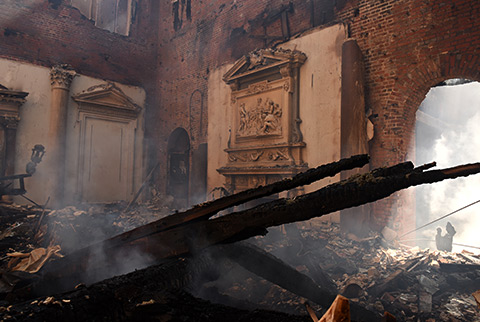Clandon Park House Fire – The Value of Specialist Restorers In Returning Historic Buildings & Contents To Their Original Condition

The fire at Clandon Park House in Surrey,
on 29 April 2015, was a symbol of both hope and despair, highlighting once again the fragility of our heritage collections and historic buildings, while demonstrating the level of dedication and expertise
that ensures the greatest chance of restoration.
According to the National Trust, Clandon Park House was one of the most complete examples of a Palladian mansion
and contained a superb collection of 18th century furniture, porcelain and textiles.
Hope amidst the devastation
The fire, which spread throughout the building, devastated all but one room but the Trust’s well rehearsed plan to identify and extract key items from historic properties in emergency situations meant many significant items were saved. Furthermore, as the forensic examination of the remains and archaeological salvage operations continued, more items were located and many have since been restored.
When you see pictures of the damage it is hard to see how anything could have survived, yet closer examination reveals statues, friezes, sculpted wall tablets, and column ‘capitals’ appear virtually untouched, in spite of the roof, ceilings and floors collapsing throughout the building, leaving only the outer walls standing. Just the Speakers’ Parlour on the ground floor remained almost intact with comparatively minor damage to the decorative plaster ceiling and smoke residues on some of the fabrics.
It is still not known for certain the extent to which Clandon Park House itself can be reclaimed and, although many of the rescued items have been recovered in reasonable condition, specialists and conservators continue to draw on all their skills to restore whatever can be salvaged.
Incidents of this type are a reminder that there will always be a need for expertise in specialist crafts and restoration techniques no longer in common usage.
Crafts in decline
Heritage crafts used to be inherited, with skills automatically handed down from father to son. Industrialisation saw the beginning of a gradual decline in the need for these skills and in today’s world many would, at first glance, consider them obsolete.
Heritage tourism, however, delivers more than £26bn to the UK economy and, even without a major incident, the maintenance and repair of historic buildings and contents is dependent on the availability of traditional skills and craftsmanship.
We have often drawn attention to the ability of specialist restorers to recover items which appear to be beyond any hope of repair and highlighted the amazing talents of specialists and conservators in salvaging damaged documents, paintings, porcelain, fabrics, furniture, photographs, floor coverings and many other objects both old and new. Fortunately their expertise is still very much in demand but some of the crafts needed to preserve building fabrics, such as brick carving and fibrous plaster moulding for example, are close to extinction.
Properties like Clandon Park House are usually rebuilt, mainly because they are incredibly valuable assets, according to Dr Simon Thurley, former Chief Executive of Historic England and English Heritage. The ongoing restoration of Clandon will continue to require the expertise of a range of traditional craftsmen and women and specialist restorers of the highest calibre.
Preserving our heritage
Clandon Park House is the latest on the list of great houses damaged by fire, which includes Windsor Castle and Hampton Court Palace. We can only hope essential specialist resources will continue to be available for many years to come, ensuring the survival of our country’s historic and priceless heritage.
Eighteen months after the fire the painstaking work of locating and extracting items identified via the premises inventory goes on, carried out by teams of specialists ranging from archaeologists to abseilers.
There has, however, been significant progress and for the first time since the fire Clandon Park opened its doors to visitors for a six week period in September and October 2016. There was free entry to the gardens, Wednesdays to Sundays, where storyboards showed the restoration journey so far and what the future holds.
Limited access to view work on the interior via a walkway had to be pre-booked via the National Trust box office.
More about the ongoing story of Clandon Park House, including video showing some of the specialist restoration techniques being used on this historic building and its contents, at https://www.nationaltrust.org.uk/clandon-park
Updated from article published in Recovery Magazine Issue 16-2
Author: Claire Johnson
Photo: The Marble Hall showing a relief by John Michael Rysbrack still in place over the chimney piece. ©National Trust/John Millar
You can also view some of the work being carried out at Clandon Park House on our Video page
